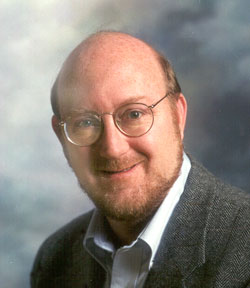2002 Distinguished Lecture Series: Murray Hitzman
An Earth Scientist Views Earth System Engineering
Biography
 Murray Hitzman received BA degrees in earth science and anthropology from Dartmouth College in 1976, an MS in geology from the University of Washington, Seattle in 1978, and a PhD from Stanford University in 1983. Dr. Hitzman worked initially as a geophysicist for Phillips Petroleum Company. He began work in the mining industry with Anaconda in 1976 at the Yerington porphyry copper mine in Nevada and subsequently worked for Anaconda in Alaska from 1977 through 1982. This experience formed the basis for his master’s thesis (on volcanogenic massive sulfide mineralization in the Ambler District, Alaska) and his PhD dissertation (on the Ruby Creek copper-cobalt deposit in the Brooks Range, Alaska).
Murray Hitzman received BA degrees in earth science and anthropology from Dartmouth College in 1976, an MS in geology from the University of Washington, Seattle in 1978, and a PhD from Stanford University in 1983. Dr. Hitzman worked initially as a geophysicist for Phillips Petroleum Company. He began work in the mining industry with Anaconda in 1976 at the Yerington porphyry copper mine in Nevada and subsequently worked for Anaconda in Alaska from 1977 through 1982. This experience formed the basis for his master’s thesis (on volcanogenic massive sulfide mineralization in the Ambler District, Alaska) and his PhD dissertation (on the Ruby Creek copper-cobalt deposit in the Brooks Range, Alaska).
From 1982 through 1993, Dr. Hitzman worked throughout the world for Chevron Resources Company. He initiated and managed base and precious metal exploration projects in Papua New Guinea, Brazil, Spain, Ireland, France, Germany, Italy, Tanzania, Canada, and the United States. In 1990 through 1993, Dr. Hitzman was manager of the Lisheen project guiding it through exploration and pre-feasibility, including engineering and environmental studies. In 1993, Dr. Hitzman was named Geological Society of America Congressional Fellow and served from September 1993 to August 1994 on the staff of U.S. Senator Joseph Lieberman (D-CT) working on natural resource and environmental issues.
Dr. Hitzman was named Executive Branch Fellow by the American Association for the Advancement for Science/Sloan Foundation during 1994. As the Executive Branch Fellow he served as senior policy analyst in the White House Office of Science and Technology Policy from September 1994 through March 1996, specializing in natural resource, environmental, and geoscience issues.
In June 1996, Dr. Hitzman became the Charles F. Fogarty Professor of Economic Geology at the Colorado School of Mines. His current research interests include carbonate-hosted Zn-Pb deposits, the Zambian Copperbelt, iron oxide Cu-Au-U deposits, zinc oxide and silicate deposits, and the role of microbes in ore formation. In 2002, Dr. Hitzman was named Head of the Department of Geology and Geological Engineering at the Colorado School of Mines. He has authored over fifty technical and popular articles on ore deposits, mineral exploration, and geoscience policy. He was awarded the Society of Economic Geologists Silver Medal in 1999. Dr. Hitzman is a Director of Mansfield Minerals Ltd. (Vancouver).
Abstract
Earth Systems Science (ESS) is becoming established as an intellectual field that examines interrelated phenomena of the geosphere, hydrosphere, atmosphere, and biosphere. Fundamental to ESS is the examination of all interactions in the earth system, from the micro to the macro scale and from the near-instantaneous to geologic time. In the strictest sense, humankind is just one interacting portion of the biosphere, but most academic programs teaching earth science systems include questions of the special relationship of humankind to the earth.
Earth Systems Engineering is an emerging field. In the meager literature on the subject, definitions range from a largely civil engineering concept to geoengineering, the conscious transformation of the planet by humans. A more pertinent definition of Earth Systems Engineering may be the practice of changing the earth system through human interventions, whether conscious or unconscious. utilizing this definition, it is clear that humans have already carried out significant Earth System Engineering; examples include anthropogenic change in soils and landscapes (geosphere), human change of groundwater quantity and quality (hydrosphere), anthropogenic induced changes in the atmosphere, and human change of ecological frameworks including biodiversity (biosphere).
Science is fundamentally about understanding nature (the why’s of the physical and biological universe); ESS looks at the physical, chemical and biological interactions of the earth system. Engineering is fundamentally about modifying nature (the how’s); Earth Systems Engineering focuses on human interactions with the earth system. But because the earth system is strongly affected by human engineering, there is a need to marry the two disciplines. To make the human connection more explicit, the field of study should probably become Earth Systems Science and Engineering (ESSE). While this modification may seem trivial, it is not. By marrying science and engineering, we bring the human element to the forefront. We can then integrate science, engineering, and the humanities—from the individual scale to the societal, including culture, philosophy, and governance—with the earth system. Thus, ESSE is truly a significant step towards understanding the coupling of human and natural systems.
It is unlikely that humans currently possess the intellectual and technological skills to successfully engage in ESSE. The complexity of the earth system is staggering; the interaction between the earth system and human systems is gargantuan. However, given that humans are already engaged in earth systems engineering, even if largely unconsciously, it becomes ethically imperative that we work towards understanding ESSE. Our first steps in this arena (for example, global climate change) have been challenging in both a scientific and engineering sense, and highly problematic from a governmental and ethical perspective. How will Mines, as an institution dedicated to the understanding and good stewardship of the earth, pursue this, the greatest challenge of the next several centuries?
